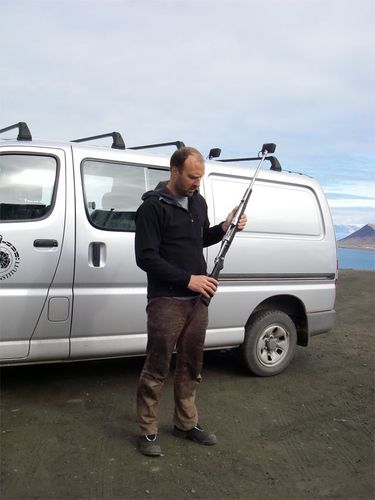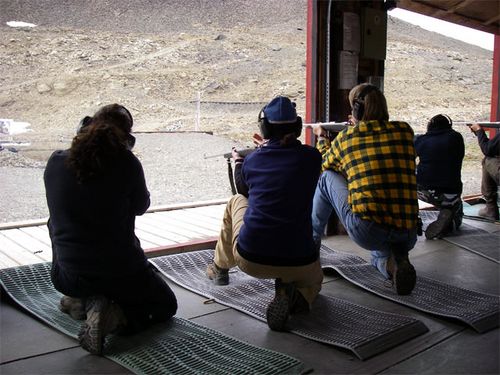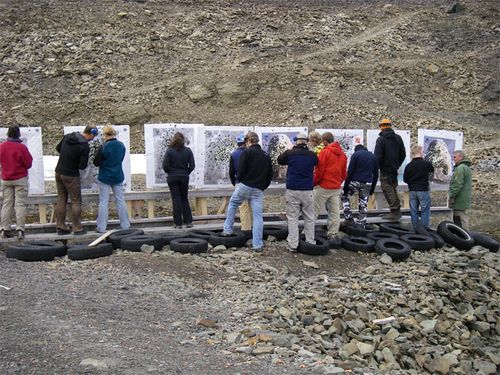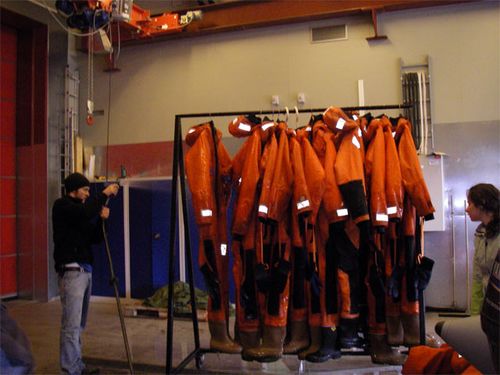While in Longyearbyen, the journal entries have all focused on orientating the readers to the expedition, and this one will do more of the same since it will talk about safety in the field. Today we attended our mandatory safety training provided by the Logistics Department at UNIS, and it started with a lecture covering all aspects of safety while pursuing Arctic research. Here are the highlights given you a sense of how to prepare for the Arctic summer.
 UNIS assisted in all the safety training and the logistics of this expedition
UNIS assisted in all the safety training and the logistics of this expedition
• Weather: 2-12° Celsius in the summer; Arctic fog is prevalent in the summer; the prevailing winds are from the west; the weather changes rapidly; and wind chill is a year-round factor • Clothing: the same as the Scandinavian autumn; windproof is more important than waterproof; carry spare clothing and plastic bags. The plastic bags are for your feet if you have dry socks to put on, but your boots are still wet. • Movement on Glaciers: 60% of Svalbard is covered in glaciers. The dangers while traversing them include crevasses, meltwater channels, moraine areas are unstable for hiking, and weather conditions are very changeable. Crampons, helmets, and ice axes are important gear to carry. As a rule of thumb while working in the front of glacier that meets the sea, stay 3-times the height of the glacier away from the glacier since the glaciers calve and displace a tremendous amount of water when the ice falls into the sea • Working on Mountainsides: there are rock falls of loose stones therefore hikers should avoid hiking around each other since the rocks slide out of place very easily; avoid gullies and ravines; there can be snow drifts in the higher mountains leading to hazardous hiking conditions; helmets and good hiking boots are important gear items for this type of terrain. • Hiking on the Tundra: Permafrost melts at the surface making for challenging hiking conditions; there is difficulty in crossing streams and this difficulty increases during the day as meltwater increases; the water spreads out in many small rivers; there should be safety gear on either side of the river, and good rubber boots are the appropriate footwear. • Movement on Sea Ice: Summer and Autumn movement is unsafe • Arctic Wildlife: Fox are cute and curious and harmless, but don't feed them since they do carry rabies and a mouse parasite. Walruses can be dangerous if they get too close on land or in small boats. Avoid conflict scenarios with polar bears by trying to walk away or trying to scare off the bear. Polar bears are protected, and can only be shot in self defense. • Field Safety Equipment: Rifle with high powered ammunition, a signal pistol with emergency flares and flares to scare off polar bears, an emergency beacon, a satellite phone, a VHF radio, map, compass, and GPS, insulated windproof bag, and emergency boxes for overnight emergencies. • Fieldwork: Always sign safety routine forms, report into the logistics office before and after field work, report health issues, listen to the safety and environmental briefings for the day, and be sure to have insurance. • Arctic Environment: Know the national boundaries and legislation. Proceed with caution.
From this talk we gained a respect for our surroundings and realized that nothing can be taken for granted when working in extreme environments. Next step for our team was rifle training. We made our way out of town to a glacial cirque where the rifle range is located and learned how to hold, load, and shoot a rifle. For some of us this was a very new experience that will remain in our minds for a long time. The force of the kick-back of the rifle after it was fired was enough throw a person backwards a couple of feet, especially someone who has never fired a gun before. Hearing the echo created from the sound of the fired rifle in the bowl of the cirque was so disturbing, but at the same time it reminded us of the danger we may be in if we encounter a polar bear. Yet for others, they enjoyed the sport in the firing the rifles and in the friendly competition of hitting the bulls-eye (poster of a polar bear). We all walked away knowing that if we are placed in a dangerous situation with a bear we need to remain calm and work as a team to ensure the safety of everyone.
 The first thing we learned in our rifle training was that there is a correct (safe) way to hold a rifle
The first thing we learned in our rifle training was that there is a correct (safe) way to hold a rifle
 Our targets were posters of poplar bears
Our targets were posters of poplar bears
 The goal was to shoot the polar bear (poster) in the upper torso.
The goal was to shoot the polar bear (poster) in the upper torso.
In the afternoon we went swimming, well sort of! Actually we had our water safety training session that started with putting on a "dry suit" (designed to keep a person warm and dry in cold water) and jumping in the water. We were instructed on how to properly put the dry suit on so that water wouldn't sneak in through any openings, and if we followed the instructor's directions (or if there wasn't a leak) we would remain dry throughout the time we were in the water. Once we jumped in the water, we all linked together in a circle to simulate what should be done in a situation while out at sea, then we linked together as a train and made our way to the shore. We made one more jump from a higher location simulating a jump from a higher boat before we took off our suits. We didn't think we'd enjoy swimming in very cold water and were almost disappointed to take our suits off after that! In the backdrop of all the seriousness, we even had a few laughs while looking like bright orange Gumby's bobbing in the water. Back at the UNIS building we were instructed on the variety of communication devices we'll be taking into the field (see the list above), and also told not to use the satellite phone to call home!
 Dave had the task of hosing down the dry suits after our water safety training.
Dave had the task of hosing down the dry suits after our water safety training.
This was an important day for all of us as we realized that we are extremely vulnerable while in the field, although with the adoption of safe field practices, it will be a safe and wonderful experience. In the Arctic, humans are not in control, it is the Arctic environment that's in control, and once that is understood, one can safely explore.
Question of the day: What safe practices do you use when you are outside enjoying nature?

